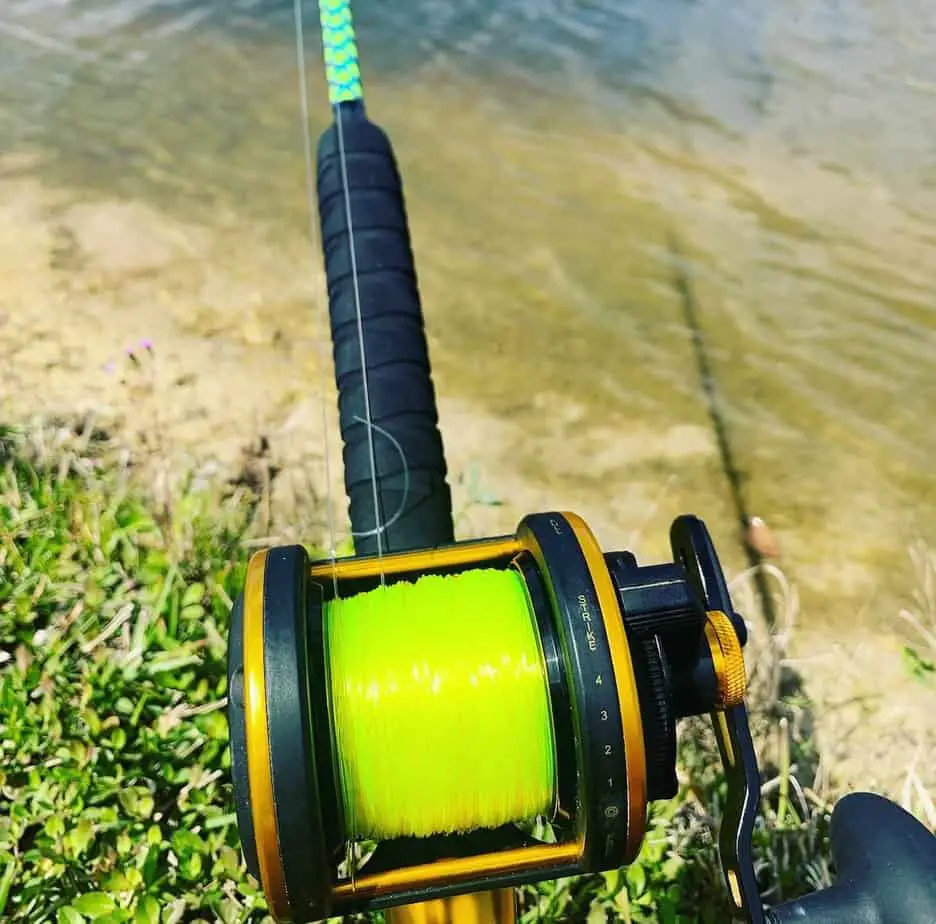Baitcasting reels are known for being more difficult to cast than spinning reels. Some people who started off with spinning reels, wonder why anyone would bother using a baitcasting reel for fear of the dreaded birds nest. Some anglers who learned to use baitcasters for bass fishing and are moving into saltwater feel that spinning reels are too easy and don’t want to lose the advantage of pin point accuracy on a baitcasting reel. Whichever school you’re in, baitcasters in saltwater can be a great tool to have in your arsenal.
Within the baitcaster category, there are low profile baitcasters, and traditional round style baitcasters. Low profile baitcasters are lightweight and ergonomic for anglers to cast repeatedly over many hours. These are best known for their use in freshwater for bass fishing, but are proving to be beneficial in inshore saltwater and nearshore casting on the beach. They typically have higher gear ratios for fast jigging artificial lures. Both types of baitcasters are praised for accurate casting.
Round style baitcasters are a more traditional style reel. Often times anglers like the nostalgic look of these reels. Round style baitcasters are your workhorses. They are intended for higher test line and hold higher line capacity. The gear ratio is typically low on these baitcasters for more cranking power when fighting bigger fish.
As you can see, these two styles of baitcasters are very different but your surf fishing strategy can be maximized by using both. I would send a long cast out with natural bait using a round style baitcaster, and then park it in a sand spike. I would probably do this with two round baitcasters paired with long 10-12’ surf rods for maximum casting distance. Then I’d have a couple spinning setups, again with long surf rods, casted out but not quite as far as the baitcasters and park them in the sand spike. Then while I wait for a fish on those, I’d be working an artificial lure with a small, low profile baitcaster paired with a shorter rod, say 7’, in a nearshore trough. This is how you can optimize your surf fishing strategy to get more lines out, at various distances, to improve your odds of success.
Now that we’ve established you’re interested in employing baitcasters in your surf fishing strategy, let’s talk about some of the products on the market and what makes these ones a great choice. I’ll talk through the specs, the price point, and the technology in each.
Let’s take a moment to explain the different features in a baitcasting reel.
If you'd like to learn more about the different types of reels, e.g. spinning, baitcasting, and conventional, head on over to our article discussing the topic.
Gear Ratio
Gear ratio is the ratio of the main drive gear to the pinion gear in the reel. The drive gear is linked directly to the handle, while the pinion gear is linked to the spool assembly. The drive gear is the larger gear. Usually these two gears are made of different materials because each gear wears differently over time. For example, when the gear ratio is listed as 5.3:1, the pinion gear turns 5.3 times for every 1 time the drive gear makes a full revolution. You can see that the teeth of the pinion gear need to be much more durable to get the same lifespan as the drive gear. The lower the gear ratio, the bigger and stronger the gear teeth are, which means it can handle the load of a big fish better. The higher the gear ratio, the faster the retrieve rate is, but if you are fighting a big fish, you’ll exert more pressure since the gears won’t be able to do it all.
Drag
Drag is the system in a reel that allows the line to flow out of the spool when certain pressure exists. The drag system consists of friction washers next to, and sometimes embedded in, the drive gear. When a fish pulls on your hook, the drag washers twist together, creating friction between them. They are specifically designed to exert a certain amount of pressure, which is your max drag. These washers are most often made of felt or carbon fiber. Each material has slightly different behavior when greased, or when wet, and they can last different amounts of time. As you might imagine, the friction between the washers generates heat, so heat dissipation is another necessary quality of the material of drag washers. If drag washers get too hot, they can warp, which affects the performance of the washer. On the plus side, drag washers can easily be replaced or upgraded as part of your long term reel maintenance.
Levelwind
Levelwind is the system on the reel that keeps the line evenly spread across the width of the spool. The levelwind system usually consists of a small gear attached to the end of the spool shaft and a nylon idler gear on the inside of the sideplate of the reel, which drives the worm gear to move the line guide back and forth. A nylon idler gear, instead of a metal one, is common to make sure the levelwind system is the first to fail if the reel experiences power it can’t withstand. This is designed on purpose so that your main drive, with the more expensive parts, stays intact. There is another design consideration in mind for a nylon gear, and that is to save your fingers if you get them pinched in the levelwind. The nylon gear teeth will shear off long before your finger does!
There are non-disengaging, or synchronized, levelwinds that work on both the retrieve and the cast. Disengaging levelwinds stay put during the cast and only move on the retrieve. Levelwinds are a source of friction during the cast, which means they tend to affect the distance of your cast. The non-disengaging levelwinds were designed as a means of mitigating the negative effect of friction your cast, while still using technology to prevent the angler from needing to evenly lay the line with his/her thumb. Levelwinds can also get in the way when fighting big fish. Sometimes the pressure is too great and levelwinds can snap off or the line can snap. This is unlikely unless you’re targeting shark or other big game species, but can still be a source of worry for anglers. For this reason, some anglers look for baitcasters that don’t have levelwinds, or look for ways to remove it themselves.
Brakes
Brakes are used during the cast to slow the spool. Brakes are necessary in baitcasting reels to prevent bird’s nests. If the brakes are set too lightly and the spool isn’t thumbed properly, the spool with spin faster than the line can leave it, resulting in a bird’s nest. There are centrifugal brakes and magnetic brakes. Centrifugal brakes have weights that must be pushed out to the edge of a flange to be engaged. These types of brakes can only be adjusted by removing the sideplate. The higher the number of weights in a centrifugal brake system, the more adjustability you’ll have. Since magnets have a tendency to corrode when exposed to saltwater, you’ll most often see a centrifugal system in a saltwater baitcaster.
Magnetic brakes work with the eddy effect of magnetics. As the spool spins, a magnetic field is created to slow the spool spin rate. The faster the spool spins, the stronger the magnetic force. These can be adjusted by a knob on the outside of the reel sideplate which essentially covers and uncovers the magnets to make them active or inactive.
Brake technology in reels has evolved and now you’ll see things like the Variable Brake System (VBS) from Shimano on a centrifugal brake system which pushes the weights out at the beginning of the cast when bird’s nests are most common, and then the weights move back inward. There are also digital brake systems, like what’s used in the Shimano Curado DC, which measures the spool RPMs at a high frequency and adjusts the magnetic field appropriately.
Bearing Counts
Bearing counts can be a misleading reel spec. Its very easy for newer anglers to assume that more bearings is better. In reality, for the smoothest castability, you need 2 ball bearings: one bearing on either side of the spool. The “+1” in the bearing count refers to an anti-reverse bearing which prevents the handle from rotating backwards. This bearing is usually near the sideplate where the handle intersects the side plate and can sometimes be a ratchet system instead of a roller bearing. Sometimes you’ll find additional ball bearings in the cast control assembly, the worm gear, the spool tension assembly, the pinion gear, and sometimes the handles. High quality bushings can be used in the cast control, worm gear, spool tension, and handle assemblies with no negative impact on performance. As you can see, the bearing count can easily be inflated as a marketing technique, without any performance benefit. For saltwater use, you’ll want to look for bearings that have additional corrosion resistance to ensure they stay running smoothly for years.
Now that you understand the aspects of reel design and how it affects reel performance, take a moment to review a table summarizing the top reels that are currently on the market.
| Baitcaster | Style | Weight | Gear Ratio | Mono Capacity | Bearings | Max Drag | Retrieve Rate | Price |
| Daiwa Coastal TW 200 | LowPro | 8.1 oz | 7.3:1 | 100 yds 20 lb | 7CRBB+1 | 15.4 lbs | 32.2 in | $240 |
| Shimano Curado DC 150 HG | LowPro | 7.8 oz | 7.4:1 | 90 yds 14 lb | 6 SARB + 1 | 11 lbs | 31 in | $260 |
| Penn Squall 300 | LowPro | 9.3 oz | 7.3:1 | 170 yds 17 lb | 6 | 24 lbs | 34 in | $190 |
| Kastking Rover Version 60 | Round | 7.2 oz | 5.3:1 | 250 yds 16 lb | 6+1 | 20 lbs | 25.9 in | $60 |
| Abu Garcia Ambassadeur C3 6500 | Round | 10.7 oz | 5.3:1 | 320 yds 12 lb | 4 | 15 lbs | 26 in | $150 |
| Daiwa Millionaire Classic UTD 300 | Round | 11.3 oz | 5.1:1 | 190 yds 20 lb | 2 + 1 | 11 lbs | 24.5 in | $90 |
| Shimano Calcutta 400B | Round | 11.7 oz | 5.0:1 | 160 yds 20 lb | 3 + 1 | 17 lbs | 24 in | $250 |
| Shimano Calcutta 400D | Round | 11.8 oz | 5.1:1 | 160 yds 20 lb | 4 + 1 | 15 lbs | 27 in | $400 |
Light Low Profile Baitcasters for Inshore or Nearshore Saltwater Fishing
Low profile saltwater baitcasters have higher gear ratios and are much more ergonomic. These are great for repeated casting for hours and hours. The lower line capacity and faster retrieve rate makes these reels great for working lures in nearshore troughs while my round style baitcasters sit in a sand spike waiting for a bite. Casting with a low profile baitcaster with a couple other lines out in sand spikes is a great way to improve your odds of catching something in the surf.
Daiwa Coastal TWS $240
The Daiwa Coastal TWS has the T Wing System (TWS) levelwind. This is a T shaped line guide where the line is in the wide part of the T during the cast and the narrow part of the T during the retrieve. The idea behind this system is that it decreases the friction during the cast that a levelwind can cause.
This reel also has 7 Corrosion Resistant Ball Bearings (CRBB) to improve its longevity in a saltwater environment. See the bearing locations in the schematic below. This reel has one of the higher bearing counts of the reels discussed here, and you can see in the diagram that 2 of them are simply in the handle to make for a smoother feeling retrieve. This reel comes with a higher price tag, but is praised by anglers all over the country.
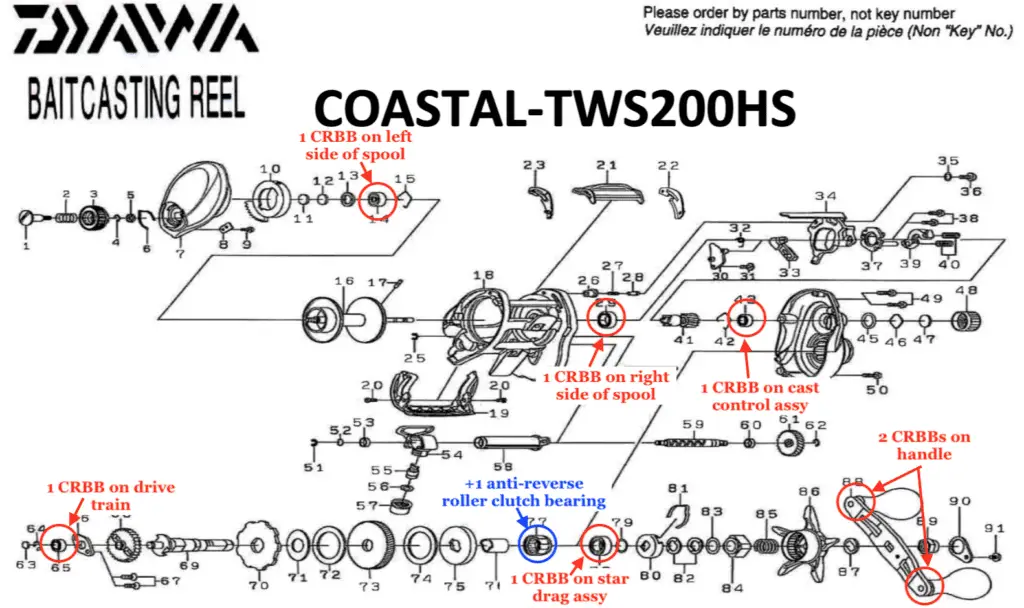
Shimano Curado DC $260
The Shimano Curado DC offers a high technology solution to the bird’s nest issue. Bird’s nests can be caused by the spool spinning faster than the line can leave it, and the digital braking system senses spool speed and slows it down as needed to prevent bird’s nest in any condition and even with light lures. Although it comes at a higher price tag, you will get the advantage of a baitcaster – accurate casting – with almost no risk of bird’s nest. Who wouldn’t want this reel?
The 200 size version of this reel was debuted at ICAST 2022. If you like the idea of digital braking and need more line capacity than the 150 size, check out the 200 size here.
The Shimano Curado DC also has 6 Shielded Anti Rust Bearings (SARB) as shown in the schematic below.
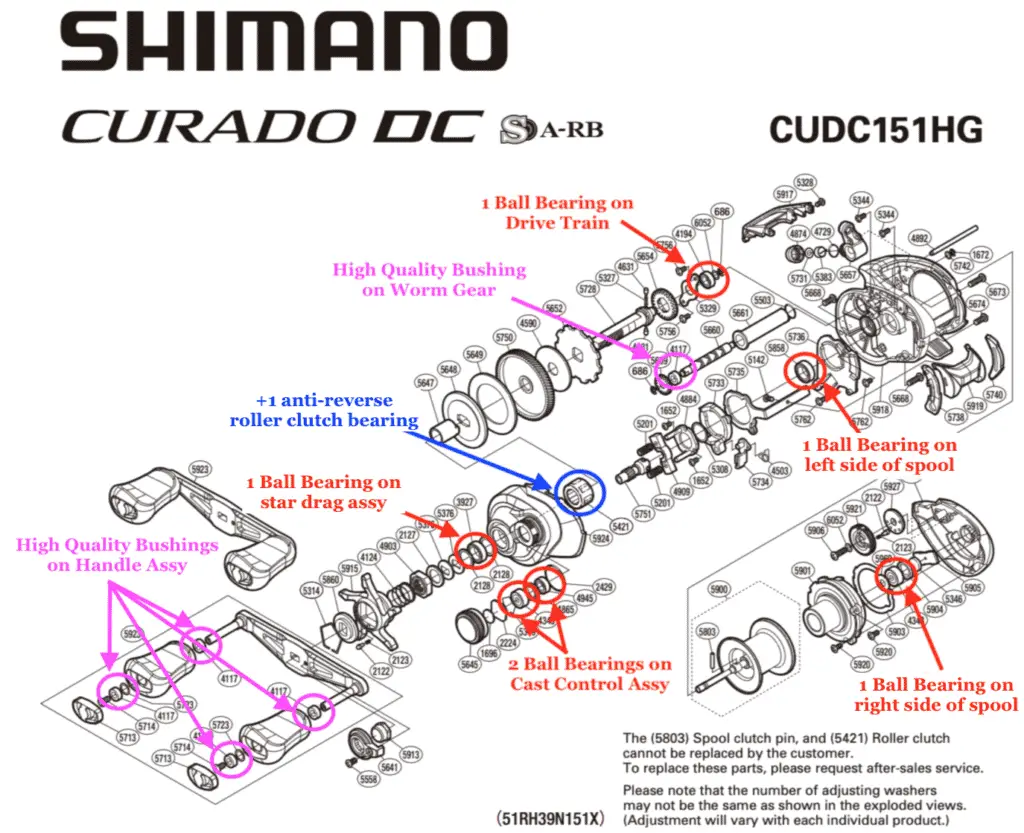
Penn Squall 300 $190
The Penn Squall is our cheapest low profile baitcasting reel we’d recommend for saltwater fishing. Penn is known for creating high quality reels, and this one is no exception. Its ergonomic design makes it great for palming for long hours and its full metal body and stainless steel bearings makes it strong enough to withstand saltwater conditions. It has 6 bearings, which I’ve pointed out below.
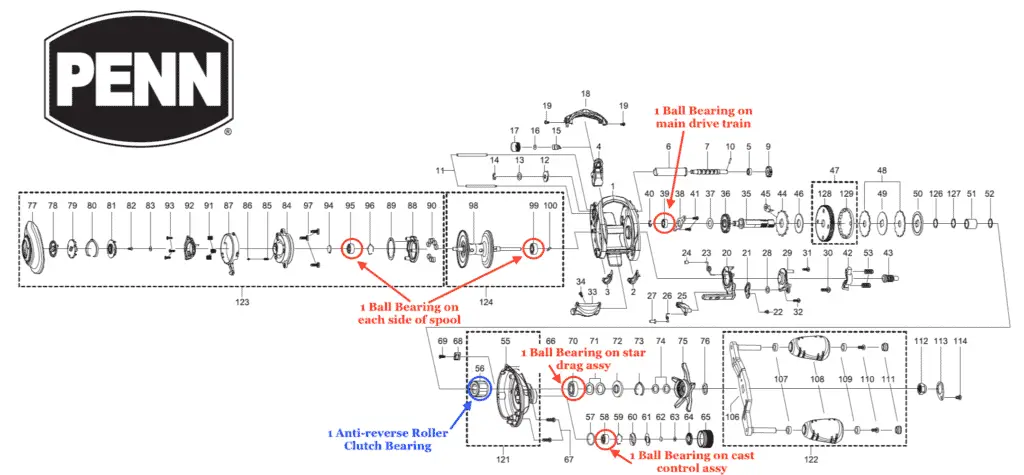
Round Style Baitcasters for Surf Fishing
These round style baitcasters generally exceed the line capacity of the low profile baitcasters. They also usually have lower gear ratios. That means these reels have great strength and can cast a mile out. They work best with heavier lures or bait. I use these types of reels for the long casting portion of my surf fishing strategy. These reels are the ones I’ll cast far out and place them in a sand spike and wait for a bite. They usually have clickers so I can hear when a fish catches and I’ll run over, pick it up and reel that sucker in.
Kastking Rover Version 60 $60
The Kastking Rover has 6+1 bearings. There are 2 bearings in the handle which help the reel feel a little more smooth. The most interesting bearing placement is the pinion bearing. Its uncommon to see a bearing in the pinion, but its done to help support the pinion during the cast when the spool is in freespool. When a pinion is disengaged, it can slouch if not supported adequately and touch the spool and add friction to your cast. The bearing placement inside the pinion prevents this from ever happening and helps maintain your casting distance. The schematic below points out the bearing locations.
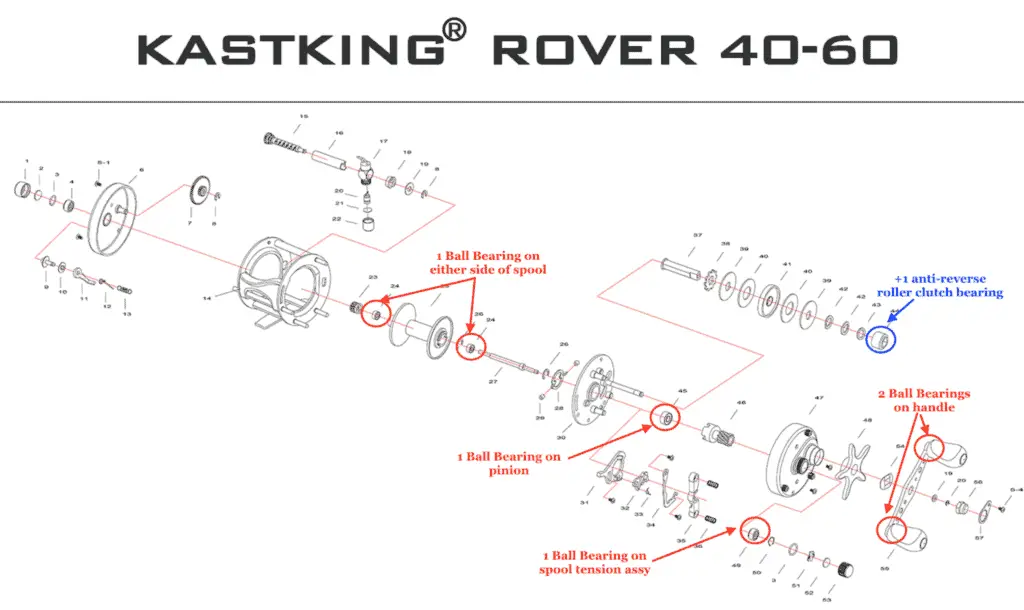
The Kastking Rover version 60 is the appropriate size for surf fishing and has a very affordable price point of $60. This is a great baitcaster to start and can become a great second reel when you grow into a more expensive baitcaster.
Abu Garcia Ambassadeur C3 6500 $150
The Abu Garcia Ambassadeur C3 6500 has a 6 pin centrifugal brake system. This higher pin count gives you more variability in the brake sensitivity settings. When you start off with using a baitcaster, you probably want the most brakes to prevent getting tangled in a birds nest on every cast. As you improve your casting skills, you can back off some of the brakes and get more casting distance. The Abu Garcia is a workhorse at a pretty mild price point of $150.
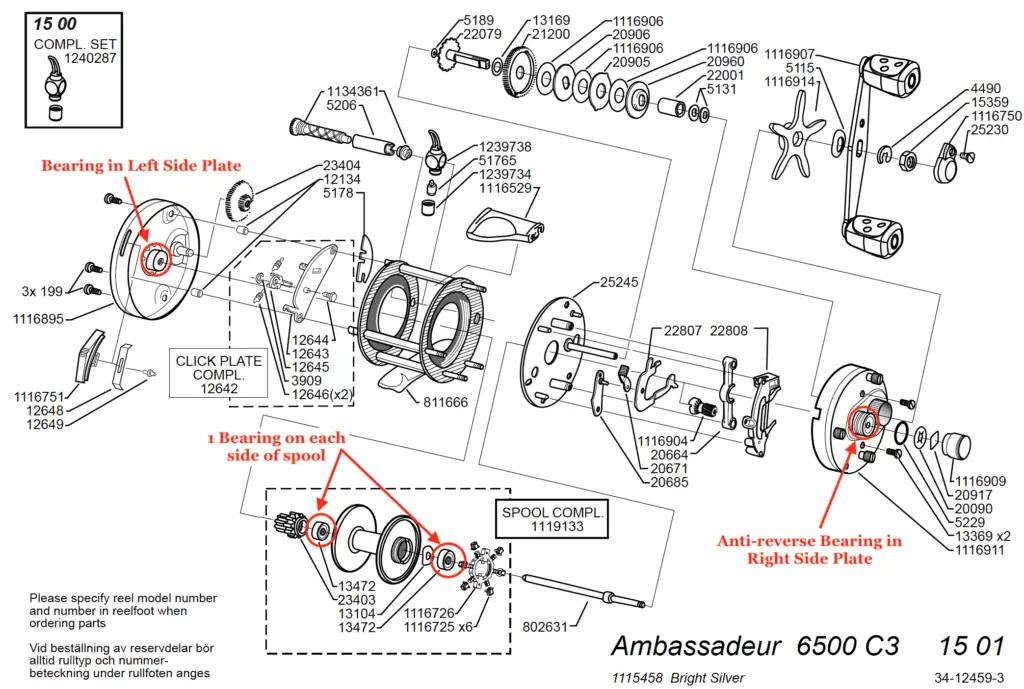
Daiwa Millionaire UTD $90
The Daiwa Millionaire UTD contains the Ultimate Tournament Drag system. The UTD uses carbon washers to exert 11 lbs of drag friction. The Daiwa Millionaire costs about $90 which is on the lower end of prices and has the lowest number of bearings. With that being said, the bearings Daiwa chose to include are the critical ones on the left and right side of the spool, and the infinite anti-reverse. These bearing locations give you the best bang for your buck in terms of smoothness.
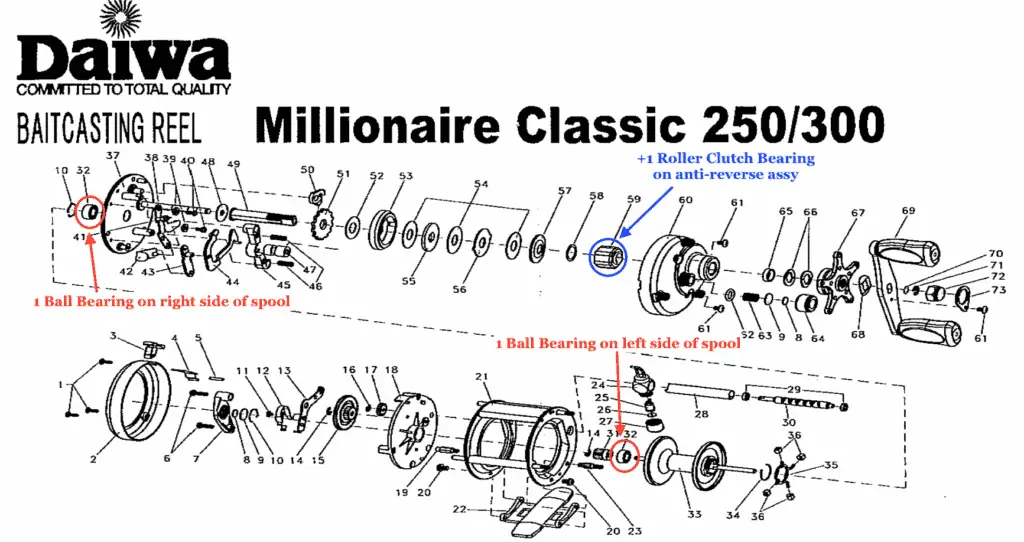
Shimano Calcutta B $260
The Shimano Calcutta B is an affordable price for a time tested baitcasting reel by a well established fishing reel manufacturer. The Calcutta B has a unique Variable Braking System (VBS) which is a centrifugal braking system in which the weights move outward on the flange during the fastest part of the cast, and move back in during the slower parts. This is a unique design and allows the angler to prevent a birds nest without sacrificing casting distance. This reel will get you far in the surf. There are 3+1 bearings in this reel and the locations are pointed out in this schematic:
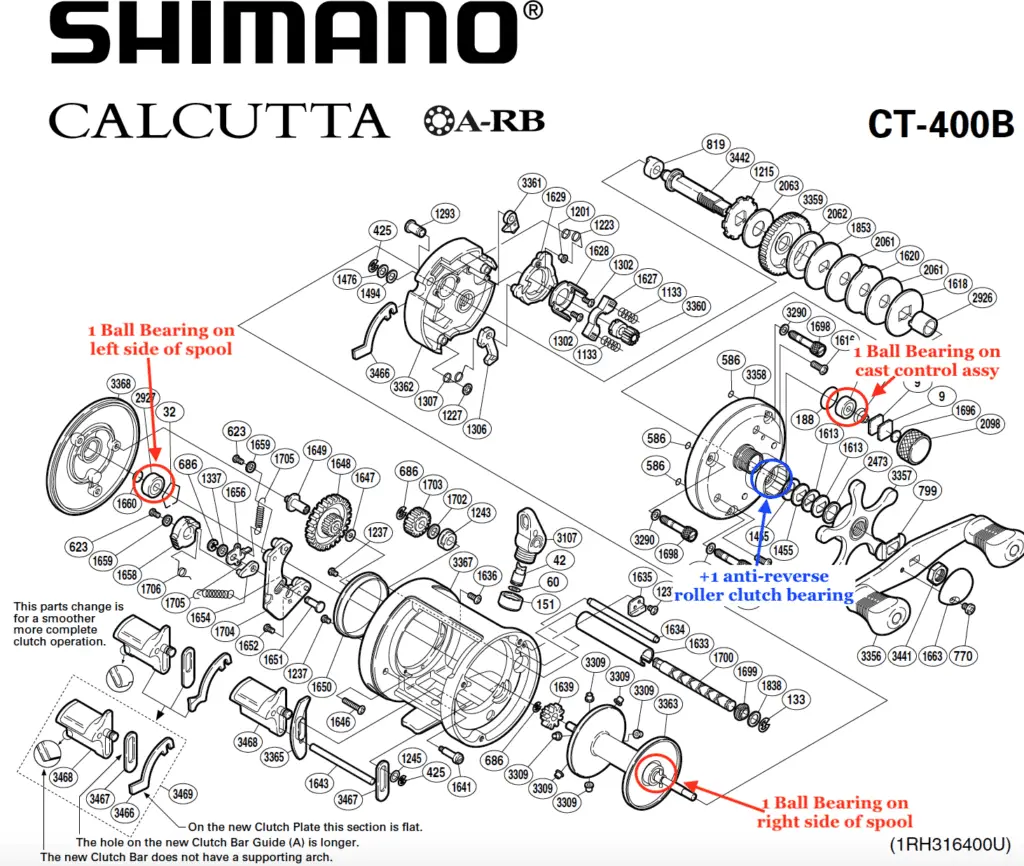
Shimano Calcutta D $400
The Calcutta D is superior to the B in a few ways. The first is the corrosion resistance of the bearings. The Calcutta B has the ARB bearings, or Anti-Rust Bearings, and the Calcutta D expands on that corrosion resistance by putting shields on either side of the ball bearings. These bearings are called SARB, or Shielded Anti-Rust Bearings by Shimano.
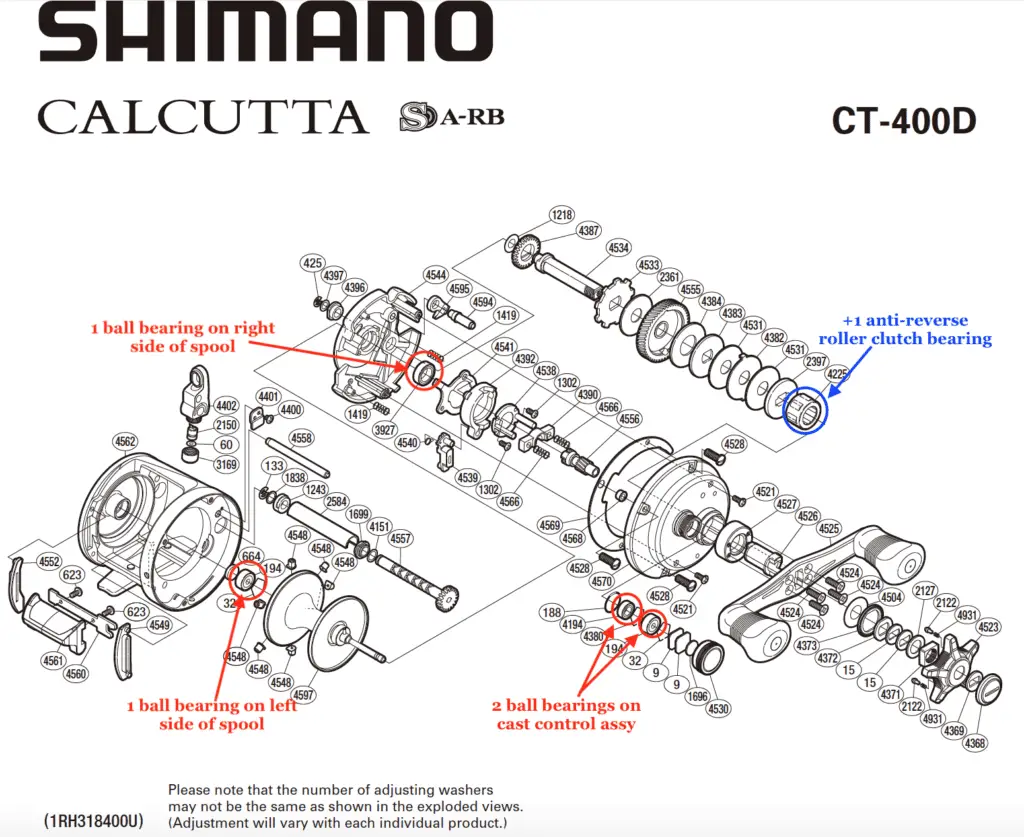
The Calcutta D has a more advance cross carbon drag system to more effectively provide friction and dissipate heat. This means you’re less likely to experience drag slipping which can be a nerve wracking thing when you’re fighting a big one.
The Calcutta D is also a smaller reel to improve the feel for most anglers. This is one of the only reels on the market in which the star drag dial is on the outside of the handle, removing some unnecessary torque on the reel when fighting and retrieving. This helps you focus your energy on retrieving and makes the Calcutta D a very effective choice for big game fishing.
If you are considering a Shimano Calcutta but can’t handle the hefty $400 price tag of the D model, you can upgrade the bearings from the B model to the SARB model yourself when you do your reel maintenance. You can also upgrade your drag washers to match the material used in the Calcutta D, and you’ve made upgrades to your B model in all the right places.
A Word About Conventional Reels:
Round style baitcasters are very often confused with conventional reels, and for good reason. These two categories of reels have many overlapping features, such as the round style, they may or may not have a levelwind system, larger line capacity and low gear ratio. The difference between the two categories is slight. Conventional reels have even higher line capacity for heavy line. These are meant for bottom fishing deep waters and trolling offshore or in the Great Lakes. The large line capacity gives these reels the capability to reach bottom in deep waters. The low gear ratio makes these reels great for trolling for big game fish and trolling with heavy hardware like planers. Often times, these conventional reels are larger so they’re impractical to use for repeated casting.
When trolling or bottom fishing for big game fish, the levelwind system ends up taking a lot of stress during the fight. You can break the levelwind system off, or it can snap your line. Both of those are unfavorable when you’ve got the fish of a lifetime on your hook, so conventionals often don’t have levelwinds, but this is not a hard rule.
I hope this article helps you choose your next reels. While you're here, check out our YouTube channel here and our 2 other articles on baitcasters in saltwater: Saltwater Baitcasting Combos and Baitcasters for Surf Fishing – All Price Ranges!
Recent Posts
Fat Cow Jig Strips: The Ultimate Bucktail Jig Upgrade for Surf Fishing
As discussed in my previous article, "Surf Fishing with Bucktail Jigs: Ultimate Guide for Beach Anglers," bucktail jigs are a staple in any surf angler's tackle box, offering a versatile way to catch...
In my previous article, "Surf Fishing with Bucktail Jigs: Ultimate Guide for Beach Anglers," I introduced you to the bucktail jig and discussed how versatile of a lure it is for catching a wide range...

